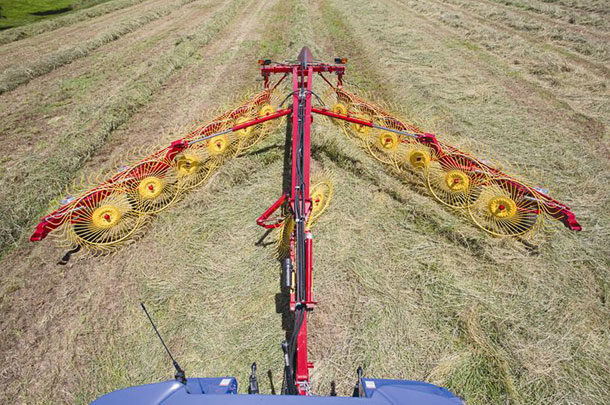Each producer has a method of choosing a hay rake based on several factors – hay quality, size of operation and desired ground speed. Hay production styles for a farmer with a mixed operation west of the Mississippi will most likely be different from that of a dairy farmer in the Eastern states. Producers must choose the rake type that provides the greatest value and hay quality.
Ground-driven wheel rakes move hay rapidly along adjacent tine-finger wheels, lifting and moving dry crops to the windrow. While side-delivery models are available, center-delivery wheel rakes (often called vee-rakes) are currently the most popular configuration. The high-capacity, fast raking speed and uniform windrow formation of vee-rakes make them ideal for use with round balers.
Rake widths are available from eight raking wheels to models with 20 or more wheels to suit each baler’s capacity. Wheel rakes are available in several different configurations: side-delivery, carted, front-folding and overhead-wheel rakes.
The vee-rake is the most popular type because of its lower price and simple operation. An economy carted wheel rake is well suited for very small acreage producers. It features tandem mounted raking wheels and a low frame profile. Such models are often lightly built and may not be suitable for larger acreages.
Deluxe carted wheel rakes
A new category of deluxe carted wheel rakes has recently appeared. While similar in concept to the economy carted wheel rakes, they feature tandem raking wheels mounted to a more robust, raised frame for extra capacity and better durability. Some rakes in this class feature independent rake wheel flotation to follow contours better. This can also reduce finger-tine wear and improve raking wheel reliability. Economy and deluxe carted wheel rake models are available in eight, 10 or 12 wheel configurations.
Front-folding wheel rakes
Front-folding wheel rakes are designed for big raking capacity. Although more expensive than carted wheel rakes, they offer dependable, high-speed raking, creating windrows that are easy to bale. Standard models with eight to 10 wheels, as well as deluxe models with 10 to 20 raking wheels, are available. From heavy windrows to thick, wide swaths, front-folding wheel rakes make short work of raking.
These larger rakes all feature rear pivoted frames for more precise contour following. Many of the largest models also support the frames with additional tires, essential when covering large widths. Individual floating rake wheels are adjusted by means of spring suspension. Working width is also controlled hydraulically, allowing for the optimization of the rake wheel angle to help reduce the amount of soil, stones and debris carried into the windrow.
Overhead or western style wheel rakes
The overhead or western style vee-rakes share individual floating rake wheels that are common with front-folding rakes, but feature a larger diameter raking wheel with heavy-duty rubber mounted tines. Compared with the traditional finger wheel concept, this raking wheel design is physically larger and heavier to engage the ground more aggressively. More positive tine engagement is ideal when raking very heavy or wet crops.
Traditionally available in odd numbers of raking wheels, these rakes offset slightly to one side to prevent depositing the windrow on damp ground and to ensure all the hay is lifted and turned by the rake. The chassis is centrally located, reducing the turning radius on headlands while providing a wide rake that is highly maneuverable against ditch lines and canals. Heavy-duty wheel rakes in this category are available with 17 or 19 raking wheels with convenient electrohydraulic controls. FG

-
Mark Lowrey
- Dairy and Livestock Marketing Specialist
- New Holland
PHOTO: The ground-driven vee-rake configuration is popular in the Western states for dry, lighter hay. Photo provided by Mark Lowrey.












